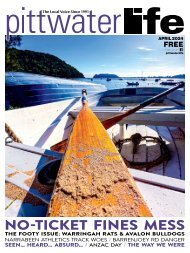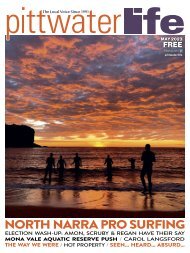Pittwater Life June 2022 Issue
- No tags were found...
You also want an ePaper? Increase the reach of your titles
YUMPU automatically turns print PDFs into web optimized ePapers that Google loves.
Surfing <strong>Life</strong><br />
with Nick Carroll<br />
Print wipeout: are surfing<br />
magazines a dying trend?<br />
2005 2013<br />
Surfing <strong>Life</strong><br />
1964 1975-76 1984 1992<br />
No doubt you’ve heard it<br />
before. “Print is dead.”<br />
This reductive sorta<br />
judgment has been bandied<br />
about in media circles, in<br />
surfing as much as anywhere,<br />
for over a decade now.<br />
But in late January (2017),<br />
when SURFING magazine<br />
actually closed its doors,<br />
surfers worldwide got a bit of<br />
a shock.<br />
The California-based<br />
SURFING had been in<br />
continuous publication since<br />
1964. As one of the two<br />
biggest surf mags in the world<br />
for much of the past 53 years<br />
(the other one being close rival<br />
SURFER), it defined the modern<br />
trend toward high-energy<br />
high-performance surfing for<br />
generations of readers.<br />
At its peak in 1989, it sold<br />
over 120,000 copies a month,<br />
employed 38 people fulltime<br />
and a couple of dozen<br />
part-time, and booked up to<br />
half a million dollars’ worth of<br />
advertising per issue, much of<br />
it from the surging young lions<br />
of the new surf industry of the<br />
day: Gotcha, Quiksilver, Body<br />
Glove and many more.<br />
A social and economic<br />
powerhouse, in fact! Yet the<br />
rise and decline of SURFING<br />
magazine tells a bigger story,<br />
about how its subject and<br />
readership has swung with<br />
social change.<br />
When it began publishing as<br />
‘International Surfing’ in the<br />
early 1960s, modern surfing<br />
was still in its birth throes. The<br />
Baby Boomers were still almost<br />
just that, babies: a third of the<br />
US West Coast’s population<br />
was under 21 years of age.<br />
The lightweight foam and<br />
fibreglass Malibu surfboard<br />
was on sale everywhere to<br />
these kids, with their new-car<br />
mobility and desire to explore<br />
the world.<br />
Like those kids, SURFING<br />
took a while to figure out who<br />
it really was. In 1967 it briefly<br />
left SURFER in the dust, rolling<br />
with psychedelia and the<br />
shortboard revolution, before<br />
settling into a bi-monthly<br />
groove – a sort of stoned<br />
stability that matched its<br />
10,000-odd readers.<br />
That lasted until 1975,<br />
when the tendrils of the new<br />
pro surfing movement began<br />
to snake their ways into<br />
California’s surf consciousness.<br />
SURFER, the self-proclaimed<br />
“bible of the sport”, turned its<br />
nose up at this tomfoolery,<br />
but SURFING’s young editor,<br />
Dave Gilovich, saw a chance<br />
to do what all good editors<br />
do – separate your mag from<br />
the competition. SURFER might<br />
be the bible, but SURFING’s<br />
tagline read, “The Hot One!”<br />
In 1978 the mag was bought<br />
by Australian emigre Clyde<br />
Packer. Clyde signed off on a<br />
monthly publication schedule<br />
and gave his young staff its<br />
head. They dragged in brilliant<br />
LA designer Mike Salisbury<br />
and turned SURFING into a<br />
bright, brash showcase for<br />
the surf stars of the 1980s.<br />
And everything lit up. The<br />
magazine kept finding new<br />
48 JUNE <strong>2022</strong><br />
The Local Voice Since 1991<br />
readers – the “echo boomer”<br />
generation, who wanted to<br />
reject everything their boring<br />
1960s parents had stood for.<br />
In that late ’80s boom time, its<br />
average reader age got down<br />
to just under 17. SURFER’s<br />
publisher tried to disparage it<br />
with the nickname “Teen Beat”<br />
– but that was just what the<br />
advertisers wanted to hear.<br />
The recession of 1991<br />
hit that whole construct –<br />
advertisers and readers – hard.<br />
But magazine sales stayed<br />
bravely above 70,000, and<br />
rebounded with the emergence<br />
of sensational Kelly Slater<br />
and his generation of young<br />
wizards. SURFING spent the<br />
1990s perfecting the role of<br />
conduit between Kelly and crew<br />
and their expanding fan-base –<br />
still youthful, yet less brash and<br />
more given to opening up new<br />
areas of surf, like Indonesia’s<br />
Mentawais chain and Tahiti’s<br />
Teahupoo.<br />
1999’s dot-com bubble had<br />
everyone predicting the End of<br />
Print. But the dot-com bubble<br />
came and went with little effect<br />
on magazines – specially not<br />
on the sharp niche press like<br />
SURFING. What did change was<br />
the ownership. A terminally ill<br />
Clyde Packer sold the title and<br />
its associated publications to a<br />
big New York publishing house<br />
for just over $20 million.<br />
In one way this sealed<br />
SURFING’s fate. Magazines –<br />
all media really – exist in the<br />
tension between ownership<br />
and readership; once you’re<br />
a niche publication in a big<br />
corporate structure, things<br />
are bound to go south. A few<br />
years and acquisitions later,<br />
SURFING, SURFER and a third<br />
younger rival, Transworld<br />
Surf, were all under the same<br />
corporate roof, forced to share<br />
The Local Voice Since 1991<br />
offices and even ad sales<br />
staff, trying desperately to<br />
chase readerships that were<br />
diffusing just as the mags<br />
themselves were congealing.<br />
Then came smartphones<br />
and social media, and<br />
that pretty much killed off<br />
SURFING’s raison d’etre – its<br />
role as conduit. What kid in<br />
a shrinking kids’ surf market<br />
needed “The Hot One” to<br />
check John John Florence’s<br />
latest clip? What surf star<br />
needed a mag when he or<br />
she had Instagram? The<br />
publication went back to<br />
eight per year, and sales had<br />
declined to something close to<br />
its 1975 average of 10,000.<br />
In the end – a very 2017<br />
end – SURFING was killed via<br />
corporate rationalising. It was<br />
it or SURFER, and “the bible”<br />
sounded better. One of the<br />
staff was game enough to<br />
offer just over $3 million for<br />
the title, but the corporates<br />
knocked it back, clearly<br />
thinking it was worth that just<br />
to prevent competition.<br />
In SURFING magazine’s 53<br />
years, Australia and the US<br />
saw 256 separate surfing titles<br />
come and go. Only a handful<br />
still exist, mostly surviving on<br />
niches within the niche: mostly<br />
older or more artisanally<br />
minded readers, who like the<br />
physical feel of a publication<br />
and who have the money to<br />
pay for it. Print’s not quite<br />
dead, but like surfing, it’s<br />
definitely middle-aged.<br />
(*I should reveal I wrote for<br />
SURFING it its glory years and<br />
was editor-in-chief of Clyde<br />
Packer’s Californian magazine<br />
stable from 1991 to 1997.)<br />
* Nick Carroll is on leave;<br />
this column first appeared in<br />
our March 2017 issue.<br />
JUNE <strong>2022</strong> 49<br />
Surfing <strong>Life</strong>

















